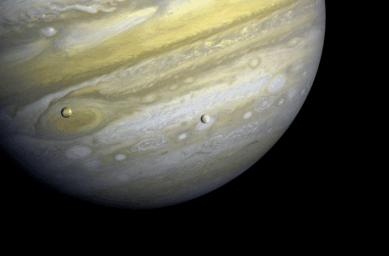
|
Jupiter with Satellites Io and Europa
- Click the image above for a larger view
- Full-Res JPEG (820 x 540) (31.3 kB)
- Full-Res TIFF (820 x 540) (821.7 kB)
Caption:
Voyager 1 took this photo of Jupiter and two of its satellites (Io, left, and Europa) on Feb. 13, 1979. Io is about 350,000 kilometers (220,000 miles) above Jupiter's Great Red Spot; Europa is about 600,000 kilometers (375,000 miles) above Jupiter's clouds. Although both satellites have about the same brightness, Io's color is very different from Europa's. Io's equatorial region show two types of material -- dark orange, broken by several bright spots -- producing a mottled appearance. The poles are darker and reddish. Preliminary evidence suggests color variations within and between the polar regions. Io's surface composition is unknown, but scientists believe it may be a mixture of salts and sulfur. Europa is less strongly colored, although still relatively dark at short wavelengths. Markings on Europa are less evident than on the other satellites, although this picture shows darker regions toward the trailing half of the visible disk. Jupiter is about 20 million kilometers (12.4 million miles) from the spacecraft. At this resolution (about 400 kilometers or 250 miles) there is evidence of circular motion in Jupiter's atmosphere. While the dominant large-scale motions are west-to-east, small-scale movement includes eddy-like circulation within and between the bands. This photo was assembled from three black and white negatives by the Image Processing Lab at Jet Propulsion Laboratory.
Background Info:
JPL manages and controls the Voyager project for NASA's Office of Space Science.
Cataloging Keywords:
| Name | Value | Additional Values |
|---|---|---|
| Target | Jupiter | Europa, Io |
| System | Jupiter | |
| Target Type | Planet | Satellite |
| Mission | Voyager | |
| Instrument Host | Cassini Orbiter | Voyager 1 |
| Host Type | Orbiter | Flyby Spacecraft |
| Instrument | Imaging Science Subsystem (ISS) | |
| Detector | ||
| Extra Keywords | Atmosphere, Color, Storm | |
| Acquisition Date | ||
| Release Date | 1996-01-29 | |
| Date in Caption | 1979-02-13 | |
| Image Credit | NASA/JPL | |
| Source | photojournal.jpl.nasa.gov/catalog/PIA00144 | |
| Identifier | PIA00144 | |
